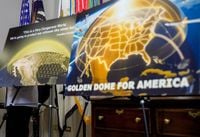On November 25, 2025, the U.S. Space Force quietly took a major leap forward in missile defense, awarding a series of prototype contracts for space-based interceptors (SBIs)—weapons designed to shoot down enemy missiles in the earliest moments after launch. This move, shrouded in secrecy and protected by enhanced security measures, marks the first tangible step in President Donald Trump’s ambitious Golden Dome initiative, a project aiming to create a layered, nationwide shield against missile threats by 2028.
According to Breaking Defense, these initial contracts—each reportedly valued at about $120,000—were handed out to multiple companies, though the Space Force has declined to identify the recipients. The awards fall below the $9 million threshold requiring public disclosure under the Defense Federal Acquisition Regulation Supplement, and, as the Space Force spokesperson explained, “The names of the contractors are currently not releasable as they are protected by enhanced security measures.” This cloak of secrecy has extended beyond the contracting process, with the Pentagon discouraging even passing references to Golden Dome at trade association events, all in the name of operational security.
Despite the hush-hush approach, some details have emerged. The contracts are structured as “prize” funds, with three one-year options for the companies to complete ground demonstrations of their prototype interceptors. Most of the development costs, however, will be borne by the companies themselves—a gamble, but one with the promise of much larger rewards down the line. The ultimate prize? Production contracts worth between $1.8 billion and $3.4 billion annually, as reported by Reuters based on Pentagon presentations.
Golden Dome, as envisioned by the Trump administration and outlined in a May 2025 Oval Office announcement, is a sprawling, multi-billion-dollar undertaking. Congress has already allocated $25 billion for the project over the next decade, with $5.6 billion earmarked specifically for space-based intercept capabilities. The broader plan, however, is far more ambitious: President Trump declared the project would cost $175 billion and reach initial operational capability within just three years. These figures have drawn skepticism from defense experts, who question whether the timeline and budget are realistic given the technical and financial challenges involved.
The Golden Dome initiative isn’t just about catching missiles in their boost phase—the fleeting minutes after launch when they are most vulnerable. The Space Force is also preparing to solicit bids for a new generation of kinetic midcourse interceptors, which would target warheads as they travel through space, providing a crucial second layer of defense. According to Bloomberg and Arms Control Association, the Space Force plans to open contractor solicitations for these midcourse interceptors by December 2025, with several fixed-price agreements expected to be awarded by February 2026. These interceptors, described as “hit-to-kill” systems, would destroy incoming missiles by direct impact rather than by using lasers or other directed-energy technologies.
The competition for these contracts is fierce and includes some of the defense industry’s biggest names. Reuters revealed that Northrop Grumman, True Anomaly, Lockheed Martin, and Anduril are among the companies that have already received initial awards for their prototype work, while others such as startup Apex Space have also pledged to participate. Apex, for instance, plans to launch its “Project Shadow” interceptors next summer, while Lockheed is targeting a demonstration in 2028. Northrop Grumman has begun ground testing of its SBIs and is providing operational analysis to the Pentagon. The government has asked contractors to develop four different versions of interceptors capable of addressing threats at various altitudes and speeds, though there’s talk of consolidating these pools into three.
The financial stakes are enormous, but so are the risks. While the Pentagon has structured the competitions with prize pools—rewarding successful on-orbit tests with up to $125 million for first place and $40 million for fifth—the cost to build and test a single prototype could range from $200 million to $2 billion, according to industry estimates cited by Reuters. This means that even the largest prizes may not fully offset the development costs, leaving companies to weigh the potential for future lucrative production contracts against the immediate financial risks.
Tom Karako, director of the Center for Strategic and International Studies’ Missile Defense Project, summed up the dilemma: “Putting all the onus on industry has potential upsides and downsides for both suppliers and the government customer. But for it to work, there will need to be some level of confidence on the front end that the customer’s commitment is not just solid in the short term, but can be counted on two, five, ten years from now.” He added that winning broader public and political support for Golden Dome would require a robust communication and persuasion campaign about the need for both offensive and defensive space capabilities.
Golden Dome’s architecture remains largely classified, but the broad outlines are clear. The system is intended to use a combination of existing sensors and new space-based technologies to provide a layered defense: boost-phase interceptors would try to catch missiles just after launch, while midcourse interceptors would target warheads as they soar through space, and other systems would provide additional opportunities for interception. General Michael Guetlein, who leads the Golden Dome effort, has briefed lawmakers in closed-door sessions, emphasizing the importance of speed and innovation in the face of rapidly evolving missile threats.
For now, the Space Force is leveraging Other Transaction Agreements (OTAs) and prize-style competitions to encourage a range of innovative solutions and to accelerate the pace of development. The hope is that by keeping the competitions open and incentivizing rapid progress, the Pentagon can avoid the pitfalls of past missile defense programs that have suffered from delays and cost overruns.
Yet, as Reuters notes, the path ahead is far from certain. The government’s own July 2025 presentation suggested that the largest prize pool—$340 million—would be split among companies that successfully complete on-orbit tests. But with industry executives warning of the high costs and technical hurdles, it remains to be seen whether the promise of future billions will be enough to sustain the current momentum.
As the U.S. embarks on this unprecedented effort to place missile defense weapons in orbit, the stakes—both financial and strategic—could not be higher. With the first contracts now awarded and industry giants racing to prove their concepts, the next few years will determine whether Golden Dome can deliver on its lofty promise or become another cautionary tale in the annals of defense innovation.





